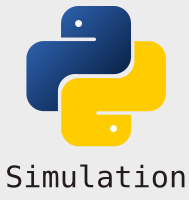Replacing simpy with ciw#
ciw is an free and open source software package for discrete-event simulation of queuing networks. It is a good alternative choice to simpy for the urgent care call centre case study. More information about ciw and how to build queuing network models can be found here: https://ciw.readthedocs.io
The approach and structure we have followed for organising and managing our simulation model logic means that we can “swap out” the simpy model for a ciw implementation without any change to the logic in our streamlit script. In this example, we will store the ciw model in its own module called ciw_model.py.
The streamlit script remains the same apart from our import statement (in practice you could just replace model.py altogether). The ciw implementation provides almost identical results to simpy (for all practical purposes its it the same.)
Details on the CiW wrappers#
We need to import ciw, rewrite the Experiment class and the single_run function.
Updated Experiment#
ciw ships with its own distribution classes. Therefore we need to make some minor modifications to Experiment
import pandas as pd
import numpy as np
import ciw
---------------------------------------------------------------------------
ModuleNotFoundError Traceback (most recent call last)
Cell In[1], line 3
1 import pandas as pd
2 import numpy as np
----> 3 import ciw
ModuleNotFoundError: No module named 'ciw'
# Module level variables, constants, and default values
# default resources
N_OPERATORS = 13
# number of nurses available
N_NURSES = 9
# default lambda for arrival distribution
MEAN_IAT = 100.0 / 60.0
## default service time parameters (triangular)
CALL_LOW = 5.0
CALL_MODE = 7.0
CALL_HIGH = 10.0
# nurse distribution parameters
NURSE_CALL_LOW = 10.0
NURSE_CALL_HIGH = 20.0
CHANCE_CALLBACK = 0.4
# run variables
RESULTS_COLLECTION_PERIOD = 1000
class Experiment:
'''
Parameter class for 111 simulation model
'''
def __init__(self, n_operators=N_OPERATORS, n_nurses=N_NURSES,
mean_iat=MEAN_IAT, call_low=CALL_LOW,
call_mode=CALL_MODE, call_high=CALL_HIGH,
chance_callback=CHANCE_CALLBACK,
nurse_call_low=NURSE_CALL_LOW,
nurse_call_high=NURSE_CALL_HIGH,
random_seed=None):
'''
The init method sets up our defaults.
'''
self.n_operators = n_operators
# store the number of nurses in the experiment
self.n_nurses = n_nurses
# arrival distribution
self.arrival_dist = ciw.dists.Exponential(mean_iat)
# call duration
self.call_dist = ciw.dists.Triangular(call_low,
call_mode, call_high)
# duration of call with nurse
self.nurse_dist = ciw.dists.Uniform(nurse_call_low,
nurse_call_high)
# prob of call back
self.chance_callback = chance_callback
# initialise results to zero
self.init_results_variables()
def init_results_variables(self):
'''
Initialise all of the experiment variables used in results
collection. This method is called at the start of each run
of the model
'''
# variable used to store results of experiment
self.results = {}
self.results['waiting_times'] = []
# total operator usage time for utilisation calculation.
self.results['total_call_duration'] = 0.0
# nurse sub process results collection
self.results['nurse_waiting_times'] = []
self.results['total_nurse_call_duration'] = 0.0
Revised single_run function.#
The single run function has the most difference in the two implementations. In simpy we define process logic using functions (or classes) whereas in ciw we define a network model (arrival/service distributions, routing percentages, servers) using the create_network function. In this example we have encapsulated all of the model building logic into get_model.
The function single_run then calls get_model and uses the simulation engine of ciw to run the network model given a set of inputs and seed.
def get_model(args):
'''
Build a CiW model using the arguments provided.
Params:
-----
args: Experiment
container class for Experiment. Contains the model inputs/params
Returns:
--------
ciw.network.Network
'''
model = ciw.create_network(arrival_distributions=[args.arrival_dist,
ciw.dists.NoArrivals()],
service_distributions=[args.call_dist,
args.nurse_dist],
routing=[[0.0, args.chance_callback],
[0.0, 0.0]],
number_of_servers=[args.n_operators,
args.n_nurses])
return model
def single_run(experiment,
rc_period=RESULTS_COLLECTION_PERIOD,
random_seed=None):
'''
Conduct a single run of the simulation model.
Params:
------
experiment: Experiment
Parameter container
random_seed: int
Random seed to control simulation run.
Returns:
-------
dict
Results of single run of the model.
'''
# results dictionary. Each KPI is a new entry.
run_results = {}
# random seed
ciw.seed(random_seed)
# parameterise model
model = get_model(experiment)
# simulation engine
sim_engine = ciw.Simulation(model)
# run the model
sim_engine.simulate_until_max_time(rc_period)
# results:
# get all results from ciw
recs = sim_engine.get_all_records()
# operator service times
op_servicetimes = [r.service_time for r in recs if r.node==1]
# nurse service times
nurse_servicetimes = [r.service_time for r in recs if r.node==2]
# operator and nurse waiting times
op_waits = [r.waiting_time for r in recs if r.node==1]
nurse_waits = [r.waiting_time for r in recs if r.node==2]
# mean measures
run_results['01_mean_waiting_time'] = np.mean(op_waits)
# end of run results: calculate mean operator utilisation
run_results['02_operator_util'] = \
(sum(op_servicetimes) / (rc_period * experiment.n_operators)) * 100.0
# end of run results: nurse waiting time
run_results['03_mean_nurse_waiting_time'] = np.mean(nurse_waits)
# end of run results: calculate mean nurse utilisation
run_results['04_nurse_util'] = \
(sum(nurse_servicetimes) / (rc_period * experiment.n_nurses)) * 100.0
# return the results from the run of the model
return run_results
streamlit script implementing ciw backend#
We modified the plotly with results filtering example to use the ciw model. The model code can be found in ciw_model.py and the streamlit script in ciw_app.py. The only line of code that is changed is from
from model import Experiment, multiple_replications
to
from ciw_model import Experiment, multiple_replications


